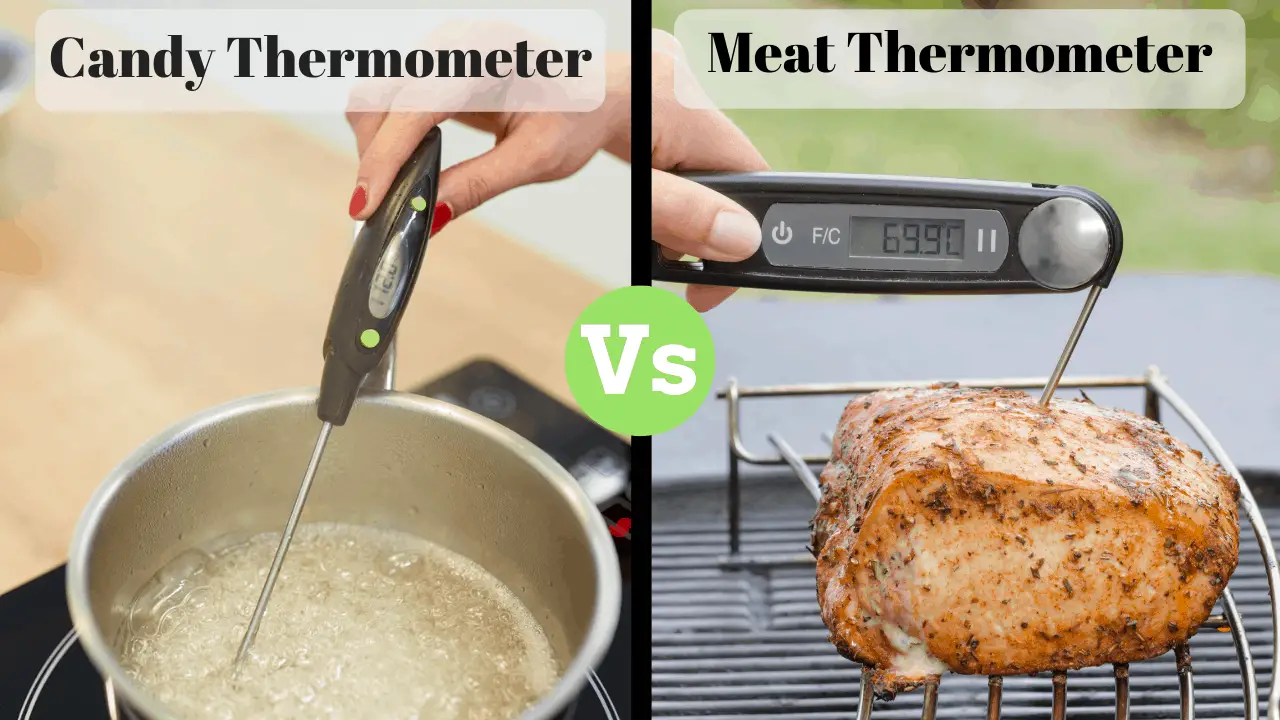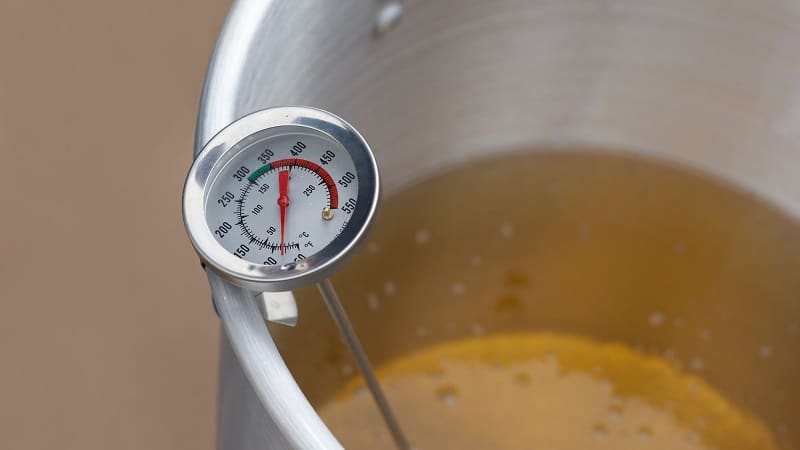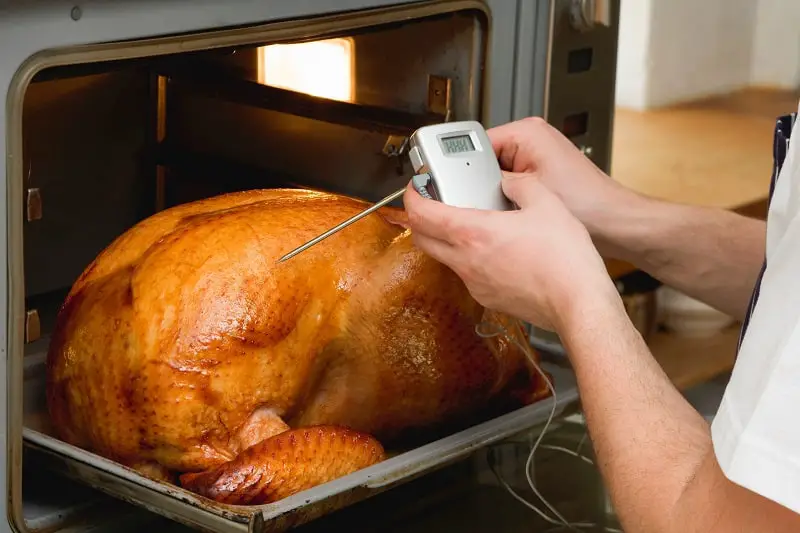Cooking pork to the right temperature can be a tricky affair. Under-cooked meat can pose some serious health issues which also need to be avoided.
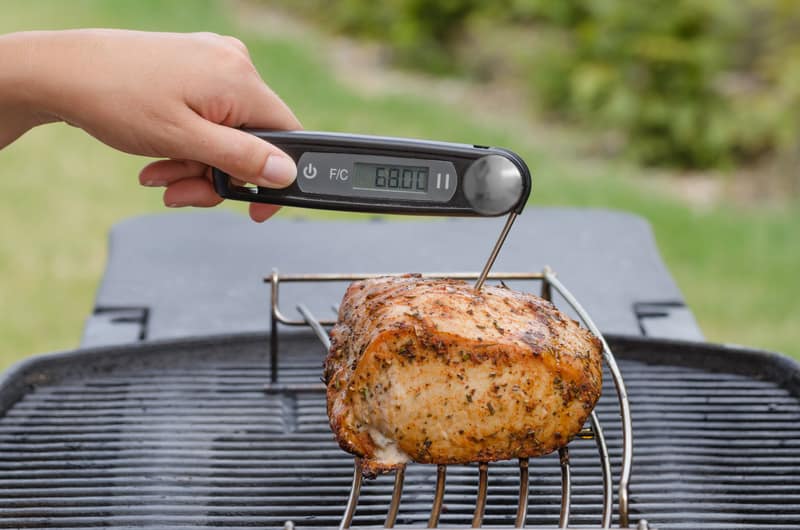
An internal temperature of 145-160° F is recommended by the FDA, for pork cooking, depending on which part or organ is being cooked. Consuming Pork that is well cooked is essential to prevent parasitic infections.
Meat that isn’t cooked well can also pose the risk of food-borne illnesses. While overcooked meat can be unfit to eat, there are even riskier threats of consuming pork that is under-cooked.
This is especially true in the case of cooking pork. Pork is prone to a number of infections. There have been eminent changes in cooking practices over the years to make sure that safety standards are met while cooking pork. This has led to developing a new set of guidelines for pork preparation where a recommended internal temperature has to be maintained.
Read along to learn about the right ways to obtain the optimum internal temperature for pork and pork related dishes. This article further focuses on using the meat thermometer and temperature guidelines for the perfect internal cooking temperature of pork.
Table of Contents
- 1 Best Meat Thermometer to Measure the Internal Temperature of Pork
- 2 How to use a meat thermometer?
- 3 Different Preparation technique of Pork and their Internal Cooking Temperature
- 3.1 1. Internal cooking temperature of Pork Chops when done & How to cook Pork Chops
- 3.2 2. Internal cooking temperature of pork tenderloin when done & how to cook Pork Tenderloin
- 3.3 3. Internal cooking temperature of Pork Ribs when done & how to cook Pork Ribs
- 3.4 4. Internal cooking temperature of Pork Sausage when done & how to cook Pork Sausage
- 3.5 5. Internal cooking temperature of Pork Roast when done & how to cook a Pork Roast
- 3.6 6. Internal cooking temperature of pork shoulder when done & how to cook pork shoulder
- 4 Preparation Tips for Cooking Pork
- 5 Final Words
Best Meat Thermometer to Measure the Internal Temperature of Pork
The internal temperature of cooking is an important aspect of achieving a healthy cook. Checking on the perfect temperature of the meat internally can give some insights into how well cooked the meat is. Even seasoned cooks can sometimes falter with the temperature if a thermometer isn’t used to keep track.
A simple way to keep the temperature in check involves the use of a meat thermometer. You can obtain an accurate temperature and a perfect cook on your pork with a meat thermometer.
Mentioned below are some of the most popular and time-tested meat thermometers that you can use to get a perfect cook:
1. ThermoPro TP03 Digital Instant Read Meat Thermometer
The ThermoPro meat thermometer is an instant reading thermometer with back-light features. It would be the most ideal for measuring internal temperature of pork if you are cooking the pork on a Grill or a BBQ.
The temperature probe is very easy to insert into the meat and reads the temperature within 3-5 seconds with an accuracy of ±0.9°F. It’s temperature measuring range of -58°F ~ 572°F (-50°C ~ 300°C) makes it ideal for measuring internal temperatures of all kinds of pork dishes like pork chops, pork tenderloin, pork ribs or pork sausages.
It is 3.9” stainless steel equipment with a 3 to 5 seconds high precision sensor. It generally retails at a price less than $15 and reflects the following features:
Pros:
- It has a wide temperature range of -58°F ~ 572°F with an accuracy of ±0.9°F.
- It has a fold-able design, is easy to use and perfect for all kinds of indoor and outdoor cooking.
- Integrated with a power-saving smart design, it initiates an auto-shut if the readout stays on for more than 10 minutes.
- It has a magnetic back with hooks for easy storage.
- A 3-year product warranty is inclusive of the product.
Cons:
- The reading detection time is slower than some of the advanced models.
- There have been quality issues observed by users in some cases.
2. Kizen Instant Read Meat Thermometer
The Kizen meat thermometer is an instant-read stainless steel waterproof thermometer. It takes the temperature within 2 to 3 seconds and is accurate up to ±1 °F.
The thermometer is water-proof with IP67 standard and ideal for measuring internal temperatures of pork, chicken, beef, fish, lamb or turkey. The biggest advantage is that it comes with a 100% money-back lifetime warranty, which is a testament for its durability and quality.
It retails at a similar price range as the ThermoPro TP03 Digital Instant Read Meat Thermometer reflects the following features:
Pros:
- It offers a wide temperature range of -58℉-572℉.
- It has a waterproof, plastic, break-resistant body.
- A convenient and clear, bright LCD screen reflects the readings.
- It comes with a premium foam lined box for handy storage.
- A bonus eCookbook on modern cooking and temperature guides is inclusive.
Cons:
- Much larger in size, might not be very portable.
- Some condensation issues are observed in certain cooks.
How to use a meat thermometer?
Using a digital meat thermometer gives an accurate reading of the internal temperature of the pork. It might appear to be cumbersome to use at first. However, using a precise temperature control is one of the most effective ways of obtaining a perfect cook.
If used correctly, a digital thermometer can, in fact, be pretty easy to use to check if the meat is cooked throughout. You need to start by understanding the basics of using a thermometer to check the cook on the meat.
A quick temperature can be gauged by following these simple steps:
- Insert the thermometer into the center of the meat. Make sure you can access the thickest part of the pork. This is the region that usually tends to remain cold and under-cooked. Checking the internal temperature on the densest area ensures a good cook on the entire meat.
- You must ensure that the meat doesn’t come in contact with a bone. The temperature reading from the bones can be an inaccurate indication of the actual cooking of the flesh.
- The thermometer should be cleaned and rinsed after every use to maintain hygiene. Also, ensure that the same thermometer isn’t used immediately after taking a temperature reading of another piece of meat. These aspects should be ascertained to make sure you receive accurate readings while cooking pork.
- Once the desired temperature is reached, you can take the meat off the stove or grill and rest it for three to five minutes. Your perfectly cooked meat can then be served to eat.
Different Preparation technique of Pork and their Internal Cooking Temperature
Different cuts require a different optimum internal temperature of cooking to kill off any bacteria or infections that the meat might contain. These precautions clubbed with prompt temperature control can help to ensure safety standards and food safety in the longer run.
Mentioned below are some ways to cook specific pork cuts to perfection and also their ideal internal cooking temperature.
1. Internal cooking temperature of Pork Chops when done & How to cook Pork Chops
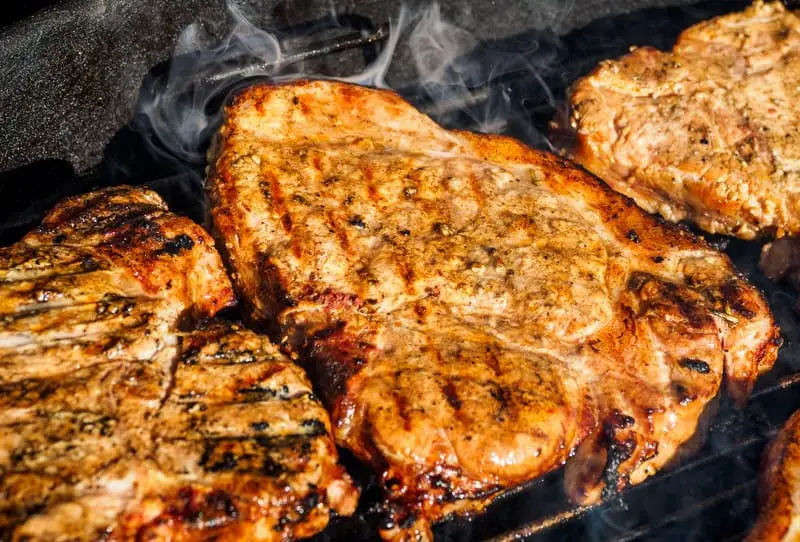
Pork chops are usually cooked to a delicious medium-rare at an internal temperature of 145°F. Higher temperatures up to 160 degrees can be attained for a medium, medium-well or a well-cooked chop.
To cook pork chops, preheat the oven according to the cook you desire. Season the pork chops with olive oil, salt and pepper. Place the chops over the heated skillet. Sear until you see a golden-brown cook.
The chop needs to be cooked until the internal temperature reached the optimum mark. Make sure to check the temperature at multiple regions to ensure an overall well-cooked chop.
Transfer the chops on to a plate and pour any juices over the top. Rest the cooked meat for 5 minutes before serving.
To obtain the perfect temperature, it is recommended to use an instant-read thermometer to resolve these common issues while cooking pork. An instant-read thermometer can pick up the temperature within seconds. It can be left in the meat while cooking, which makes it even more convenient for use. You can also use a continuous-read thermometer. These are used in the meat during the entire cook. You can keep an accurate tab on the cooking meat and pick the exact optimum temperature for cooking.
2. Internal cooking temperature of pork tenderloin when done & how to cook Pork Tenderloin
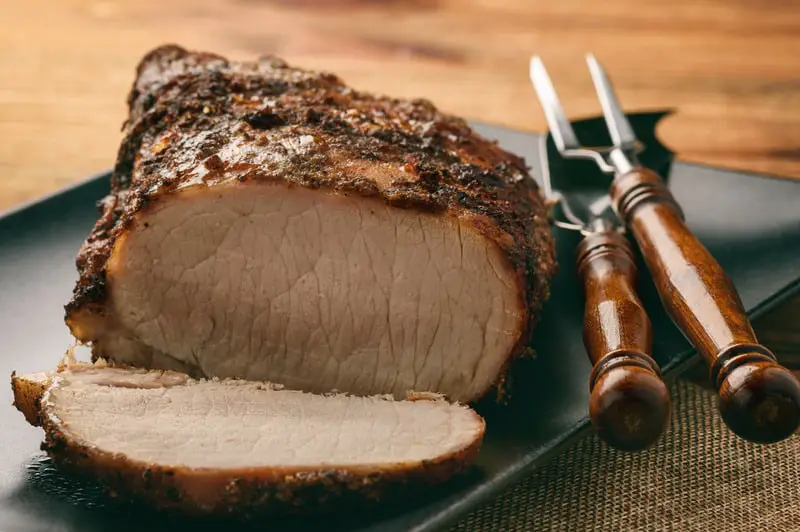
While we understand the danger of under-cooked meat, pork tenderloins can often be overcooked and become dry. A perfect cook can be seen as a flush pink roast at an internal temperature of 145°F.
A common mistake that is often made is avoiding a rest period for the sensitive tenderloins. The three minute rest period allows the juices to flow back to all parts of the pork tenderloin, which otherwise tends to be dry or overcooked. Resting the meat helps attain a juicy pink texture, which is much desired.
To cook tenderloins, you can either bake or BBQ them. You can also roast or stuff them as per your preference—season and roast your tenderloin to 145 degrees for a medium cook. You can glaze your fillets with some honey and serve them. Remember to rest the meat for 5 minutes before cutting it.
Make sure you don’t freeze the tenderloins in storage, as the texture and quality of the meat could be affected. Frozen meat might not cook to the best tenderness, which is why prompt refrigeration is enough to keep it healthy. Sometimes, this might result in some moisture loss and a drop in quality due to the defrosting process. Thus, it is better to cook the frozen raw foods as early on as possible. These can be wrapped and refrigerated too.
3. Internal cooking temperature of Pork Ribs when done & how to cook Pork Ribs
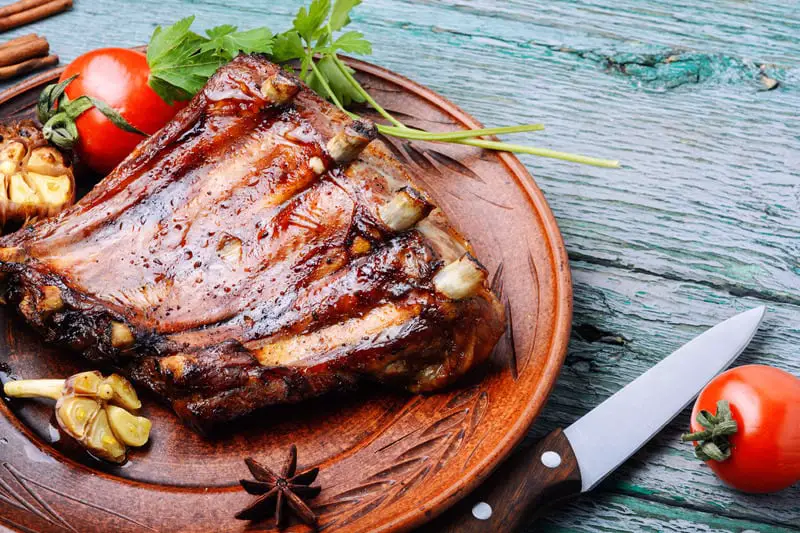
The best way to cook ribs is to cook them at low temperatures for longer periods. This brings out perfectly tender and juicy pork ribs. Pork ribs can be prepared to 160 degrees of internal temperature and above depending on the level of cook you want to achieve.
Rinse your ribs in cold water and dab them dry. Massage the seasoning into the meat, seal and bake at a constant temperature until tender. You can grill or broil to finish the dish.
For a healthy cook, ensure that the cooking environment is hygienic. Any contact with other cooked food can contaminate raw meat. This can also infect other cooked foods that might be cross-contaminated from the raw meat. Healthy segregation in the cooking environment can help avoid any such forms of contamination.
4. Internal cooking temperature of Pork Sausage when done & how to cook Pork Sausage
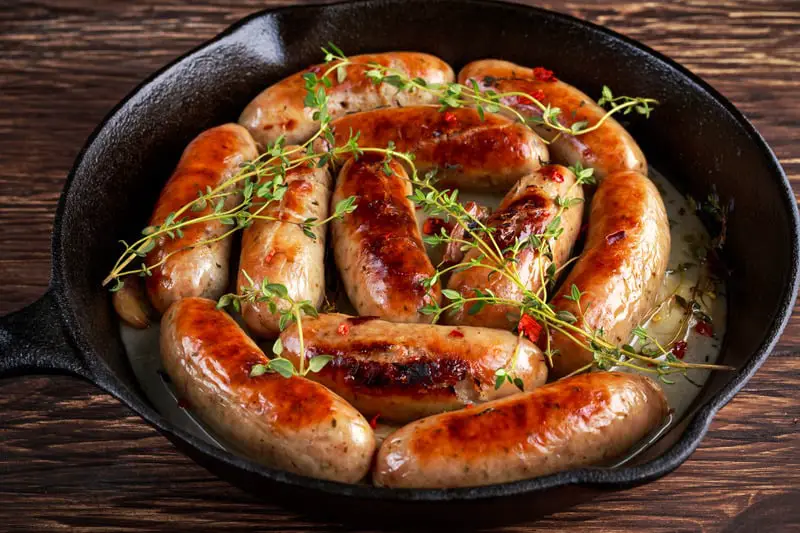
Pork sausages are pretty tricky to cook, right! Place your sausages on the skillet and cook to 160 degrees Farenheit of internal temperature for a medium-rare. Add onion and garlic with a sprinkle of oil. You can also serve the sausages with bell peppers, chillies, salt and pepper to taste.
Cutting the pork in suitable portions before cooking can ensure a uniform cook on the meat. If the meat is cut too thick, there are higher chances of some rawness being retained at the core. You should consider the impact of the heat and size of the meat to achieve the optimum internal cooking temperature.
For the storage of pork, you need to ensure that a good temperature is maintained to store the meat safely. In any case, it is advisable to use fresh pork as it will cook better to attain the perfect internal temperature.
5. Internal cooking temperature of Pork Roast when done & how to cook a Pork Roast

Pork roasts, steaks, chops and ham can be cooked at 145°F, while other meat cuts might require to be cooked at a higher temperature to kill any bacteria or infection present in the tissues. Ground pork or organ meat can be cooked at 160 degrees to be healthy for consumption.
To prepare the best pork roast, start by preheating the oven to 350 degrees. Prepare garlic, salt and pepper mix to use as seasoning with some olive oil. Place the meat into the oven and cook till an internal temperature of 145°F is attained. Serve with some pan juices and vegetable platter.
Both raw and cooked pork can be maintained at a temperature below 40° F in the refrigerator. Storage for up to four days can keep the meat fresh, but some spoilage might occur in a longer period.
6. Internal cooking temperature of pork shoulder when done & how to cook pork shoulder

How you prepare the pork shoulders before cooking can also have a significant impact on attaining the perfect internal temperature. This involves the handling, cutting, storage and cooking of the meat with other foods.
To cook a delicious pork shoulder, preheat the oven to 450°F. Season the meat and cook to 195°F internal temperature for a tender and juicy cook. Let the meat sit for three minutes to soak in the juices. Serve with some fresh roasted vegetables, salt and pepper for taste.
When it comes to the handling of pork shoulders, the proper refrigeration of the meat can go a long way in ensuring it remains healthy. Fresh cuts of pork can be wrapped up and kept in the freezer. When wrapped well, these can be stored for even months without any contamination.
Preparation Tips for Cooking Pork
Before cooking your pork, some general preparation tips can be kept in mind to keep the meat healthy for consumption:
- To prevent your pork from drying out, you can wrap it up before storing it. Wrapping up the meat tightly can avoid any exposure to air as well as keep its juices intact.
- Sometimes bacteria from other foods can contaminate the meat stored in the refrigerator. To prevent any such growth on your pork slices, store the meat in a separate compartment or the bottom rack of the fridge to keep it healthy and bacteria-free.
- Other than attaining the perfect internal temperature, it is also necessary to ensure that the cooking environment is kept sanitary. Make sure you use separate utensils and boards for cutting and cooking different foods.
Final Words
Thus, the guidelines for cooking pork can help to attain the perfect internal temperature. These regulations have changed considerably over the course of the past decade. Practicing food safety is a must to avoid the onset of food-borne illnesses.
Using a digital thermometer can be a sure way of monitoring the cooking temperature to ensure a thorough cook on the meat. While cooking, the thickest part of the pork should be checked for a good cook. Following these set guidelines can help avoid the risk of any infections that might have crept into the meat tissues. Even though the cooking of the meat is an integral aspect, the proper handling and storage of the pork can also reduce the risk of possible bacteria and other infections.
We hope this article provided an enlightening perspective for all cooking enthusiasts. Pack your flavors in by maintaining the recommended healthy cooking internal temperature. Use the best meat thermometers listed above to cook your pork right through to the center. Happy Cooking!



